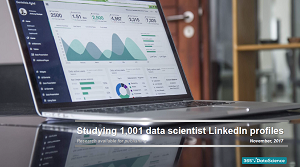 Data science is a super-hot topic and the data scientist job is the sexiest job of the 21st century according to the Harvard Business Review. But how does one actually become a data scientist? For you it doesn’t really matter how others became data scientists. What you are interested in is whether you can become one. You can ask around, read Quora answers, or talk to someone in the industry. But these methods will yield information biased by someone.
Data science is a super-hot topic and the data scientist job is the sexiest job of the 21st century according to the Harvard Business Review. But how does one actually become a data scientist? For you it doesn’t really matter how others became data scientists. What you are interested in is whether you can become one. You can ask around, read Quora answers, or talk to someone in the industry. But these methods will yield information biased by someone.
If you want to become a data scientist, you should approach the problem as one.
Well, that’s exactly what 365 DataScience did. They gathered data from 1,001 publicly listed LinkedIn profiles of data scientists and prepared a compelling report “Studying 1,001 Data Scientist LinkedIn Profiles.” Obviously, the underlying assumption that drove their research is that one’s LinkedIn profile is an unbiased estimator of one’s CV. Therefore, with a “reasonable degree of scientific certainty,” they found some amazing insights in this new report. Aggregate data for a research effort of this type is the best data, as it will keep the data of the data scientists included in the research private, while highlighting the main drivers of their career success.
Here are some key findings of the research:
- R (53%) and Python (53%) are the programming languages that dominate the data science field. Other popular languages are SQL (40%), MATLAB (19%), Java (18%), and C/C++ (18%)
- 58% of the data scientists come from one of three educational backgrounds: Computer science (20%), Statistics and Mathematics (19%), and Economics and Social Sciences (19%). There are fewer people who studied Data science and analysis (13%), Natural Sciences (11%), and Engineering (9%)
- The leading employer for data scientists is the Tech industry (42%), with the Industrial Sector (37%) following closely by. The Financial and Healthcare industries account for 16% and 5% of data scientists, respectively
Download the report HERE.
Sign up for the free insideBIGDATA newsletter.





Speak Your Mind